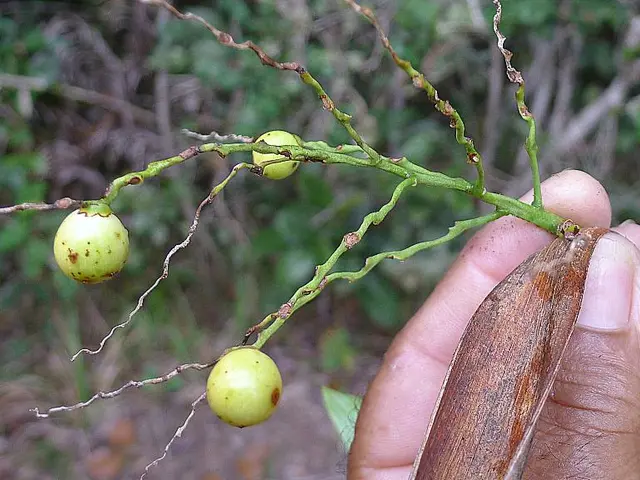Throat-based swellings originating from thyroglossal duct remnants, their characteristics, and identifying methods
Thyroglossal duct cysts (TDCs) are a common condition in children, usually presenting as a painless, midline neck mass that moves with swallowing or tongue protrusion. Early detection and treatment are crucial for preventing complications and ensuring a successful recovery.
### Diagnosis
The diagnostic process for TDCs typically begins with a clinical examination. A healthcare provider will inspect the neck for the presence of a cyst and assess its movement. If a cyst is detected, a referral to an ear, nose, and throat (ENT) specialist is usually made for further evaluation.
Imaging tests, such as ultrasound, CT scans, or MRI scans, are often used to visualize the cyst and its relationship to surrounding anatomy. In some cases, contrast dye may be used to improve the imaging quality. Blood tests are also conducted to check the thyroid gland's function and ensure normal thyroid presence and activity.
Fine needle aspiration (FNA) may be performed to analyze the cyst's contents and rule out malignancy, although malignancy in TDCs is rare.
### Treatment
If an infection is present, antibiotic therapy is administered to treat it. In cases where the infection does not resolve, incision and drainage may be performed as a temporary measure before surgery.
The definitive treatment for TDCs is the Sistrunk procedure, a surgical removal of the cyst along with the middle portion of the hyoid bone and the tract extending up to the base of the tongue. This procedure reduces the risk of recurrence to about 2.5% and is considered curative.
In rare cases where surgery is not feasible, alternative treatments such as drainage or sclerosing injections may be considered to remove the cyst or provide temporary relief.
### Post-Treatment Recovery
Following the Sistrunk procedure, a person may need an overnight stay in a hospital and will be prescribed painkillers according to individual requirements. It is recommended to rest for up to three weeks, avoid driving for two weeks, and long-haul flights for two months to ensure proper healing. A follow-up appointment will be necessary to monitor post-operative recovery.
In conclusion, a combination of clinical assessment, imaging, and surgical management is essential for the accurate diagnosis and effective treatment of TDCs in children. Early referral to an ENT specialist and appropriate imaging are key steps in ensuring a successful outcome.
- If you suspect a Thyroglossal duct cyst (TDC) in children, initiate a clinical examination to inspect for a midline neck mass that moves with swallowing or tongue protrusion.
- After detecting a cyst, seek a referral to an ear, nose, and throat (ENT) specialist for further evaluation and diagnosis.
- Imaging tests, like ultrasound, CT scans, MRI scans, or even specialized ones may be required to visualize the cyst and its relationship with the surrounding anatomy.
- Contrast dye may be used to improve the imaging quality during the diagnostic process.
- Blood tests are essential to check the thyroid gland's function and ensure normal thyroid presence and activity.
- Fine needle aspiration (FNA) may be used to analyze the cyst's contents and rule out malignancy, although malignancy in TDCs is rare.
- Once the cyst is detected, it's crucial to manage infections, if any, with antibiotic therapy.
- If the infection does not resolve, incision and drainage may be performed temporarily before the Sistrunk procedure.
- The Sistrunk procedure is the definitive treatment, involving the surgical removal of the cyst along with the middle portion of the hyoid bone and the tract extending up to the base of the tongue.
- Alternative treatments, such as drainage or sclerosing injections, might be considered if surgery is not feasible or for temporary relief.
- Post-treatment recovery requires hospitalization for an overnight stay, followed by painkiller prescriptions tailored to individual needs.
- Patients need to rest for up to three weeks, avoid driving for two weeks, and abstain from long-haul flights for two months post-surgery for proper healing.
- A follow-up appointment is necessary to monitor post-operative recovery and ensure successful healing.
- Science plays a vital role in the diagnosis and treatment of various medical conditions, such as TDCs, chronic diseases like cancer, respiratory conditions, digestive health issues, and eye and hearing problems.
- Understanding health-and-wellness, fitness, sexual health, and mental health is crucial for maintaining wellbeing and managing conditions like autoimmune disorders, skin conditions, neurological disorders, and aging.
- Workplace-wellness initiatives, nutrition education, and weight management programs, along with Medicare, cbd products, and therapies and treatments, help manage the impact of medical conditions and promote a healthy lifestyle.
- Parenting resources, women's health information, and men's health guides can offer support and guidance in managing various health aspects, including skin care, reproduction, and aging.







